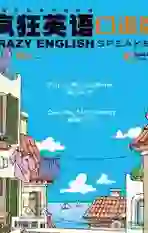非法移民面面观
2013-10-12

Celeste Headlee (Host): 1)Anthropologists and 2)archaeologists, of course, study the way that groups live throughout history. Thats exactly what Jason De Leon is doing, although hes not looking at ancient Egypt or some other long-lost civilization. He heads the Undocumented Migration Project. And that project looks at some of the things immigrants crossing the border between Mexico and the United States leave behind. And hes trying to find out what that can teach us. So how did you first get the idea to even study this?
Jason De Leon (Archaeologist): In a former life, I was a very traditional archaeologist and during the course of fieldwork in Mexico and in Latin America I met a lot of migrants, or people who were former migrants who had lived in the United States for different periods of time. Id gotten really interested in their stories and what it was like to cross the border undocumented. And I started thinking about different projects that 3)revolved around immigration.
And one night over dinner, I was having a little bit of a meal with a friend and she said to me, “You know, I used to do archaeological surveys in Southern Arizona looking for ancient sites and I have occasionally come across things that undocumented border crossers have left”. And she jokingly said to me, “You know I think someone could do some kind of weird archaeological project focused on the things that immigrants leave behind”. A week later, I bought a ticket and was standing in Arizona. About a month later, looking at a giant pile of migrant belongings and I realized that I could use my former skills in archaeology to understand this 4)clandestine social process.
Headlee: What are some of the 5)artifacts that people leave behind?
Leon: We currently have over 10,000 cataloged items and weve looked at, I would say, probably closer to about 35,000 items. And its a full range of things. All the things you would need to survive the desert: food, water, extra clothes, first aid equipment, as well as a lot of personal things—love letters, 6)rosaries, Bibles, photographs of family, diaries.
Headlee: Crossing the border seems like such an exceptional event. What do later generations learn from these artifacts that youve collected?
Leon: Well, you know, weve been migrating for the entire history of our species and weve been leaving stuff behind throughout the process. So looking at the material traces of immigration today is quite similar to if I were studying ancient Sahara crossings or the westward expansion in the 18th and 19th century in the United States.
Looking at it today, though, we see with immigration policy, the way that its been evolving over the last 10 years, is migrants are responding to immigration changes in a lot of different ways. As its gotten more dangerous, people have tried to get better at preventing physical injuries, maintaining 7)hydration, and trying not to die along the way.
Headlee: And you have found this through the artifacts, I mean, what do the artifacts tell you about how peoples approach to this border crossing has changed over the years? Leon: When I first started this project, we found a lot of weird, kind of, personal things. Things thats you would think were strange to carry with you across this harsh desert. They make sense if youre leaving your home country, possibly forever, you want to bring some personal items, things that you cherish deeply. Over the course of the last five years, weve seen that people are less and less bringing these personal things and are more focused on just staying alive.
So the actual technology that migrants have adopted has evolved, youve got specialized water bottles now, specialized backpacks, fairly systematic first aid kits that people will carry with them. And theyve learned through the course of several years of these crossings, and some people doing multiple crossings will get smarter about what to bring and what to leave behind.
Headlee: How was that different then, say from a migration a thousand years ago, a few hundred years ago? What are we seeing in this particular area thats different from our ancestors?
Leon: I think that there are a lot of 8)parallels between this migration, the great Irish migration in the 18th and 19th century. People who were leaving their homes for economic reasons or for social reasons and theyre bringing a few things with them that—to remind them of home, but then also trying to survive while 9)en route. So I do think that there are a lot of similarities.
Where I would say that the differences start to 10)pop up are that what migrants go through in the desert today, are happening right now, is one of the most systematic routinized forms of violence, I think that is occurring on domestic soil. People have 11)ratcheted up their tolerance for pain and for suffering, and migrants are incredibly hardy coming through this environment.
And what Ive seen, just over the last five years is that the tolerance for pain and suffering and for death has really kicked up incredibly. So I think youve got this more rapidly evolving migration process and its one that is more violent and 12)traumatic than any American migration story weve ever seen, outside of the West African slave trade.
西莉斯特·海德里(主持人):人类学家和考古学家当然是研究历史长河里,物种群居的方式。那正是贾森·德·利昂所研究的范畴,尽管他不是着眼于古埃及或其他消失已久的文明,他负责非法移民项目。该项目研究一些移民穿越墨西哥和美国边境而遗留下来的东西,他在试图从物品中发现一些值得我们借鉴的东西。那么开始你是怎么想到要研究这些的?
贾森·德·利昂(考古学家):在以前的生活里,我是个非常传统的考古学家,在墨西哥和拉丁美洲野外工作期间,我遇到了很多移民,或者一些不同时期在美国居住过的人,他们以前也是移民。我对他们的故事,对他们如何非法穿越边境的情况很感兴趣,于是我开始考虑以移民为中心的不同项目。
一天晚餐,我在和朋友吃顿便饭,她对我说:“你知道,我以前常常在南亚利桑那州做调查,寻找古迹,我偶然间发现了一些非法越境者留下来的物品。”她开玩笑地对我说:“你知道我认为有人会做一些奇怪的考古项目,比如专攻移民们留下来的物品。”一个星期后,我买了一张机票飞抵亚利桑那州。一个月后,我找到了一大堆移民的物品,我意识到可以用以前考古学用到的技能来研究这个秘密的社会过程。
海德里:移民们留下的人工制品都有些什么?
利昂:目前我们有超过一万种物品,我可以断定,我们已经找到了接近三万五千件物品,各种各样的物品都有。所有这些东西足以满足你在沙漠生存的需要:包括食物、饮用水、备用的衣服、急救装备,还有很多个人物品——情书、念珠、圣经、家人的照片和日记。
海德里:穿越边境似乎就像一件异乎寻常的事。后辈能从你收集的人工制品中学到些什么?
利昂:嗯,你知道,在人类的整个历史中,我们一直在迁徙,在整个过程中,我们不断在舍弃物品。所以从所留下物品的线索来看,今天的迁徙跟我正研究的穿越古撒哈拉沙漠或18世纪和19世纪美国向西部扩张时的迁徙是十分相似的。
然而看看今天,我们看到随着移民政策的修订,移民方式在过去十年也在变化,移民们以很多不同的方式回应着移民政策的变化。随着移民过程更加危险,人们要想方设法更好地避免身体创伤、保持不脱水,竭尽全力以免客死路上。
海德里:你从那些人工制品中了解到了这些,我的意思是,从那些人工制品中你了解到人们穿越边境的方式在这些年有怎样的变化?
利昂:当我开始着手这个项目时,我们发现了很多奇怪的个人物品。带着这些物品穿越艰难险阻的沙漠,你会觉得很奇怪。如果你离开家乡,可能一辈子,你想带些个人物品,一些你非常珍视的物品,(这样想的话)这些物品就显得有意义了。在过去的五年时间里,我们看到人们越来越少带这种个人的物品,而是更多地只是专注于存活下来。
所以移民采用的实际技术也进步了,现在你看到人们会携带专业水壶、专业背包和相当齐备的急救包。他们经过多年对穿越边境的学习,有些人多次穿越变得更加精明,知道该带什么,该舍弃什么。
海德里:那么如果说到一千年前,几百年前,移民有什么不同?我们在这个特殊的领域看到的移民状况跟我们的祖先有什么不同?
利昂:我认为迁徙都有很多相似的地方,比如18世纪和19世纪爱尔兰人的大迁徙。人们因为经济原因或社会原因离开家乡,他们随身带着一些物品,以纪念自己的家乡,但是他们也设法在路途中存活。所以我认为有很多相似之处。
要说到不同,我立刻想到的是今天人们如何穿越沙漠,那是正在发生的事,我认为那是最系统常规的暴力方式之一,无论是在移民本土还是在穿越边境的过程中。人们加强了自己对痛苦和伤害的承受力,但穿越这样的环境,移民们要承受不可思议的艰苦。
就我所看到的,在过去的五年来,移民要承受的痛苦、伤害和死亡的危险真的难以置信地提高了。所以我认为移民进程的更快速发展,导致的暴力和伤害比任何美国移民故事里看到的更大,这种危险几乎等同于西非的奴隶贸易。
